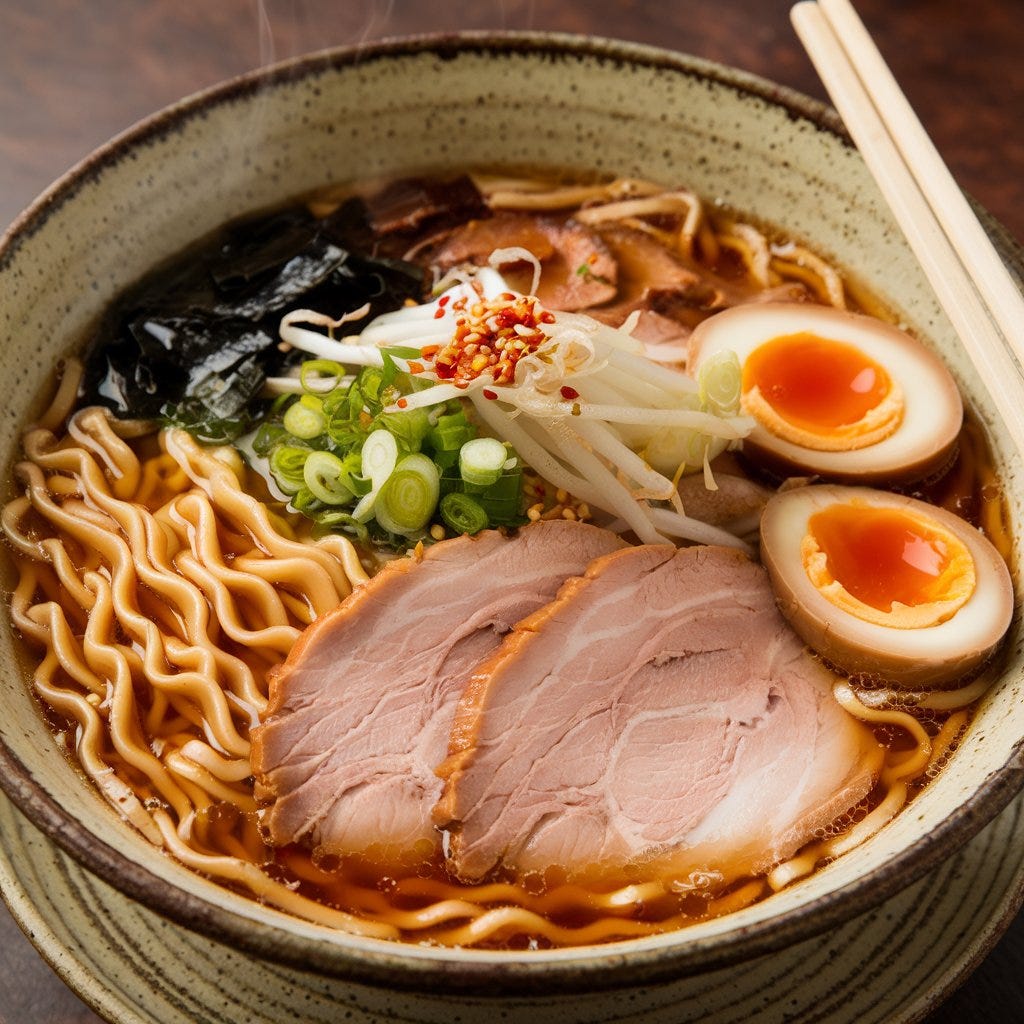Ramen noodles, a cornerstone of Asian cuisine, have gained immense popularity worldwide. Originating in Japan, these noodles offer a perfect balance of comfort, taste, and customization. Whether you're a seasoned home chef or a beginner looking for a quick meal, ramen allows for endless creativity with its combination of savory broths, chewy noodles, and a variety of toppings. This complete guide will walk you through everything you need to know about cooking ramen, from preparing the broth to choosing the perfect toppings.
Ingredients You’ll Need:
Before diving into the steps to make ramen, here is a list of essential products you’ll need to bring for this recipe:
1. Ramen Noodles
The foundation of any ramen dish. Ramen noodles come in different varieties:
Fresh ramen noodles: Often found in Asian grocery stores, they have a chewy texture and cook quickly.
Dried ramen noodles: Commonly available in supermarkets, these are typically pre-packaged and slightly more affordable.
2. Broth
The soul of the ramen, broth defines the dish's flavor profile. Here are some popular options:
Tonkotsu (Pork Bone Broth): A rich, creamy broth simmered for hours using pork bones. This is the base of many traditional ramen bowls.
Chicken broth: A lighter, more versatile option that is easy to make or find pre-made.
Vegetarian broth: Made with ingredients like kombu (seaweed), shiitake mushrooms, and miso paste for a depth of flavor without meat.
Miso broth: A savory and slightly sweet broth using fermented soybeans for a robust taste.
3. Proteins
Adding protein to your ramen turns it into a more complete meal. Options include:
Chashu (braised pork belly): A tender, melt-in-your-mouth meat often seen in traditional ramen.
Chicken: Grilled or poached chicken slices are a lighter alternative.
Tofu: Perfect for vegetarians or anyone looking to add a plant-based protein.
Soft-boiled egg (Ajitama): Marinated in soy sauce, these eggs are an iconic ramen topping.
4. Vegetables
Vegetables add texture, color, and flavor to your ramen. Common choices include:
Spinach or bok choy: Bright green, leafy vegetables that complement the broth.
Mushrooms: Shiitake, enoki, or button mushrooms add an earthy, umami flavor.
Corn kernels: Sweet and juicy, they balance the savory flavors.
Bean sprouts: Fresh and crunchy, these add a lightness to the dish.
5. Seasonings and Toppings
Ramen is highly customizable with a variety of toppings that enhance flavor and texture:
Soy sauce: A staple seasoning that adds salty, umami flavor.
Miso paste: Perfect for creating a richer, more flavorful broth.
Nori (seaweed): Adds a briny, oceanic taste.
Sesame oil: A few drops enhance the nuttiness of the dish.
Green onions: Freshly sliced, these add a sharp, bright bite to balance richer ingredients.
Chili oil or flakes: For a spicy kick, add according to taste.
Recommended Kitchen Tools
Take control of your meals with ease! Our meal planner helps you organize your weekly meals, stay on track with your health goals, and simplify grocery shopping. With customizable templates, balanced recipes, and time-saving tips, meal planning has never been this simple or stress-free. Start planning smarter today!
Step-by-Step Guide to Cooking Ramen
1. Prepare the Broth
The broth is the foundation of your ramen dish. You can use store-bought broth or make it from scratch for a more authentic flavor.
For chicken or vegetable broth: Heat your broth in a large pot, adding ingredients like garlic, ginger, soy sauce, and miso paste to enhance flavor. Let it simmer for 20-30 minutes.
For tonkotsu (pork bone broth): This broth requires a longer cooking time. Simmer pork bones, garlic, and ginger for at least 6 hours (or up to 12 hours) for a rich, creamy texture. Strain and reserve the liquid.
2. Cook the Ramen Noodles
While the broth is simmering, cook your ramen noodles.
Bring a pot of water to a boil.
Add the ramen noodles and cook according to the package instructions. Fresh noodles typically take 2-3 minutes, while dried noodles take 4-5 minutes.
Drain the noodles and set them aside.
Pro tip: Avoid overcooking the noodles, as they will continue to soften once added to the hot broth.
3. Prepare the Toppings
While the broth and noodles are cooking, prepare your desired toppings.
For soft-boiled eggs: Boil the eggs for about 6 minutes, then transfer them to an ice bath to stop the cooking process. Once cooled, peel the eggs and slice them in half.
For chashu (braised pork belly): Sear the pork in a hot pan until caramelized, then braise in a mixture of soy sauce, sake, and sugar for about an hour until tender.
For tofu: Slice the tofu and pan-fry until golden and crispy on the edges.
For vegetables: Quickly blanch spinach, bok choy, or bean sprouts in boiling water for a few seconds, then drain.
4. Assemble the Ramen
Once everything is prepared, it’s time to assemble the dish.
Place the cooked noodles in a large bowl.
Pour the hot broth over the noodles until they are fully submerged.
Arrange your protein (pork, chicken, tofu) on top of the noodles, followed by vegetables like spinach or mushrooms.
Add a soft-boiled egg, green onions, nori, and any other toppings of your choice.
5. Add Finishing Touches
Drizzle a bit of sesame oil or chili oil over the bowl, and sprinkle with sesame seeds for added flavor and texture. Season the broth further with soy sauce or miso paste if needed.
6. Serve and Enjoy
Serve your ramen immediately while it's hot. The noodles should be slurped up along with the broth for the best experience!
Conclusion
Cooking ramen noodles at home allows you to enjoy a warm, comforting bowl of this Asian favorite whenever you like. The beauty of ramen lies in its flexibility—whether you prefer a simple miso broth with tofu or a rich tonkotsu with chashu pork, the combinations are endless. By following this guide and bringing the right products together, you can create a satisfying, authentic bowl of ramen that caters to your personal tastes.




